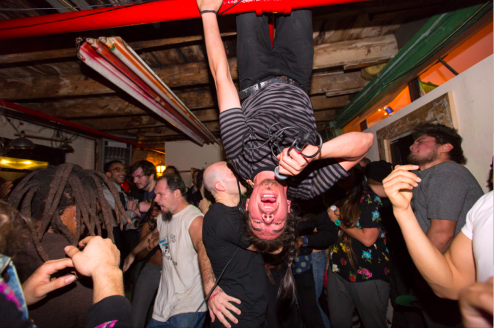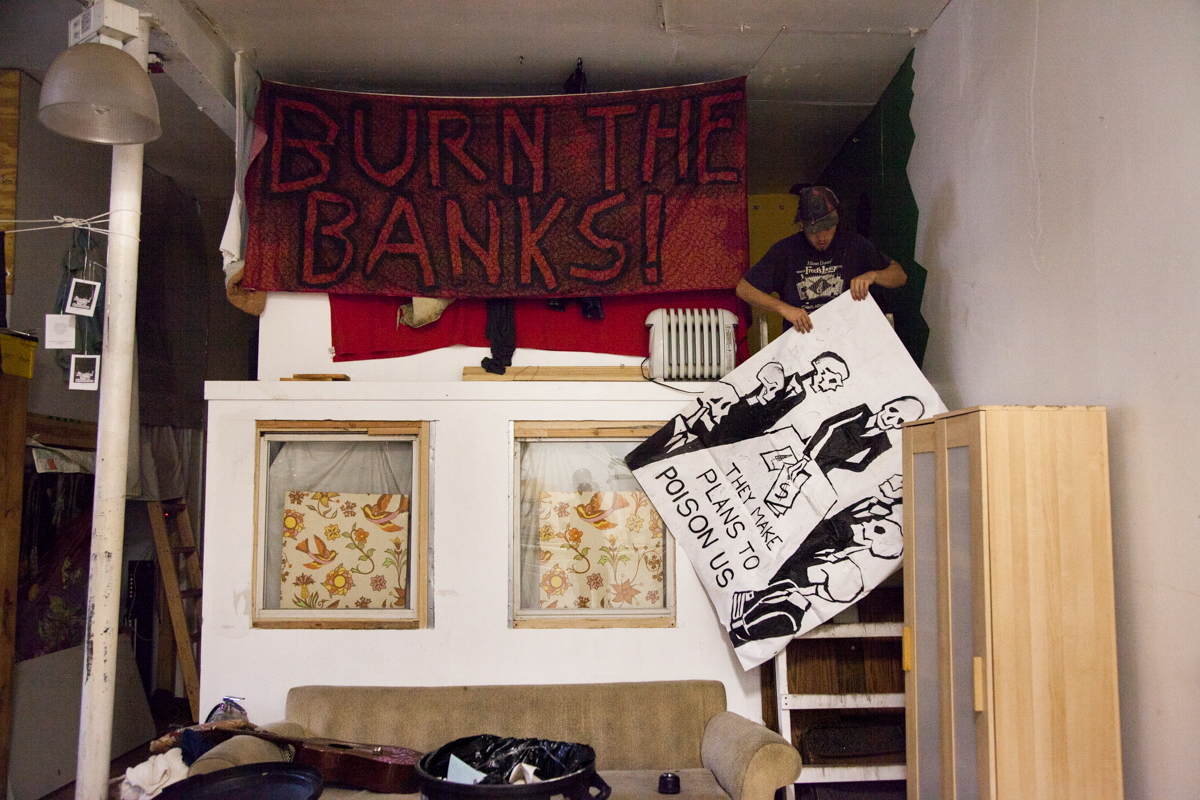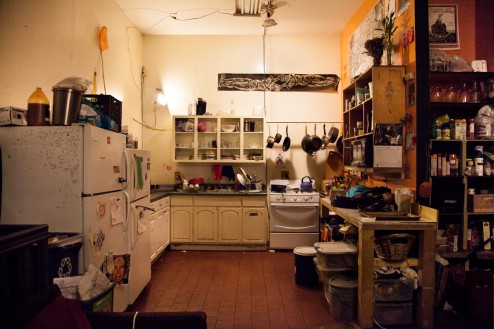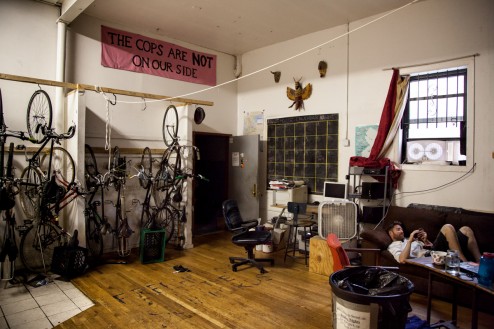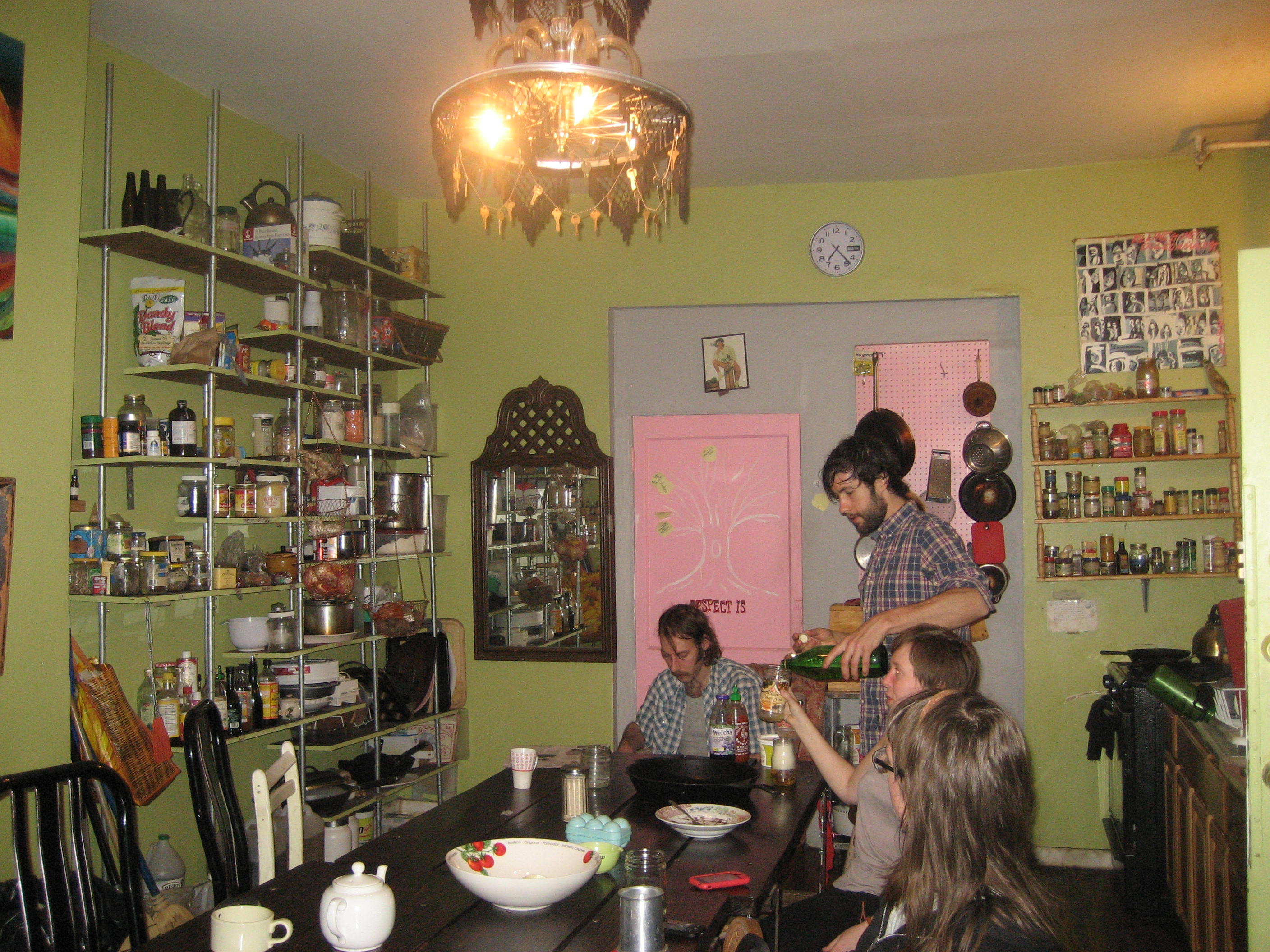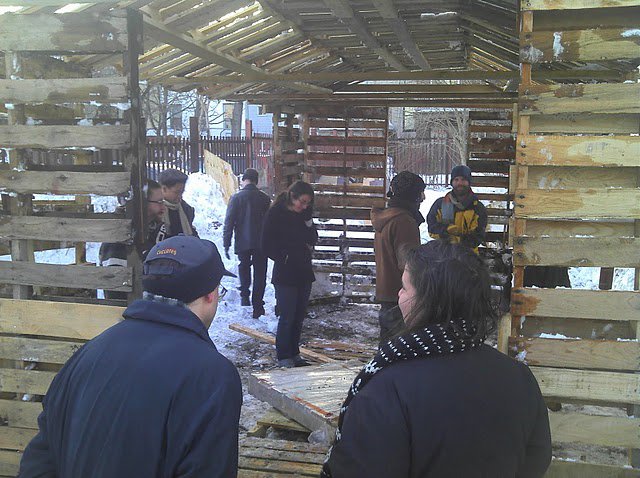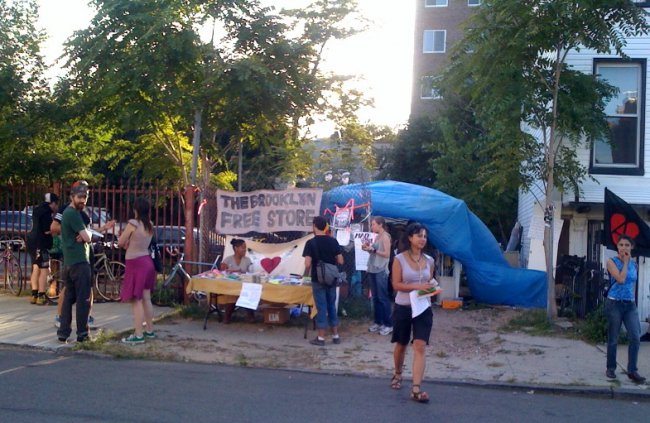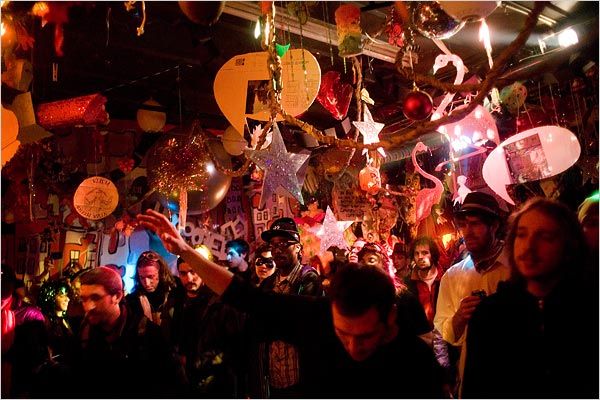
photo from the New York
Times
neighborhood: bed-stuy | space type: parties & art space | active since: 1993 | links: none (sorry!)
update December 2011: Rubulad is moving! After nine years in
South Williamsburg and six in Bed-Stuy, this amazing space is hunting for a new
home. And they’ve just completed a down-to-the-wire Kickstarter campaign, raising over $35k to help them on
their way. It remains to be seen where they’ll go, but it’s
clear this vital community will continue to grow and inspire creative culture
for years to come.
***
Rubulad—along with House of Yes, the 123 Community
Center, and a handful of others—is what inspired me to start this
project in the first place. For fifteen years, Rubulad has been an incubator of
creative art and culture in New York; it’s one of the oldest,
longest-running paeans to cultural experimentation, wild beauty, art for the
sake of art. The influence of the space on Brooklyn’s creative class is
impossible to overstate.

photo by E.A.R.
Rubulad is a huge, stunning, two-floor warehouse on the Bed-Stuy / Crown Heights
border, and is both notorious and revered for the massive themed parties
they’ve been hosting for over a decade. The events include installation
art, eclectic performances, film screenings, and musicians, and attract a
diverse crown, the majority of whom dress up in elaborate costumes to fit the
themes.

photo by E.A.R.
Remnants of every one of the parties still adorn every inch of visible space—the
walls, ceilings, rooftop, furniture, backyard, and garden are teeming with a
dizzying array of decorations, from framed shellacked jellybeans to
glitter-painted stuffed animals to a giant birdcage with a carousel horse
inside.

photo by E.A.R.
In addition to the parties, Rubulad has also been home to many more intimate
events, like kids’ days, smaller music performances, benefit parties, and art
shows. Grub, the bi-monthly freegan community dinner
bottom-lined by In Our
Hearts, was held here for years. Want to hear how it all began? Read
through for my interview with Sari, one of Rubulad’s founders.
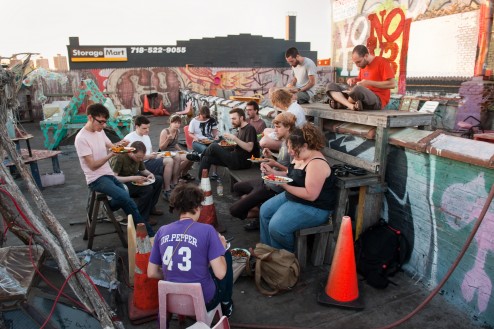
Grub, photo by Julia
Roberts
brooklyn spaces: When did you start doing
this and why?
Sari: We’ve been going in different
incarnations since ’93. It was started by four bands: Fly Ashtray, Uncle Wiggly, Smack Dab, and the Gamma Rays.
Together we rented a huge place in South Williamsburg, back when things were
cheap.

photo by E.A.R.
brooklyn spaces: Did you start right off
throwing parties?
Sari: Well, we had this big space full of
all these artists and musicians. And it felt a little flat to all the bands to
just be playing in bars and not have any kind of control over the environment.
We wanted to take a hand in that and say, “We’d like this band to play with
these other performers, and then show these projections, and have a little play
in between.” And we just invited the neighborhood in.

photo by me
brooklyn spaces: What were some of the
obstacles you faced when you left Williamsburg for this new space?
Sari: One obstacle was the neighborhood.
It took a while for people to want to come to Bed-Stuy. It’s hard to imagine
that now, but even five years ago, people were like, “What? The G train?! You’re
kidding!” But things moved quickly.

Grub, photo by Julia
Roberts
brooklyn spaces: Let’s talk some more about
the art and the artists.
Sari: I come at this as kind of a director
of a show. My dream is to create a holistic piece of art, an experiential
environment that many different people had a hand in. Our desire is to create
work for people, and for people to get other work from having been here. The
artists here have a chance to really evolve. We’re kind of family-oriented; lots
of artists come back to do work here again and again, and so we get to see how
they change and what happens to their art over several years. It’s really nice
to give artists an opportunity for that growth, as opposed to just doing one
show here, one show there.
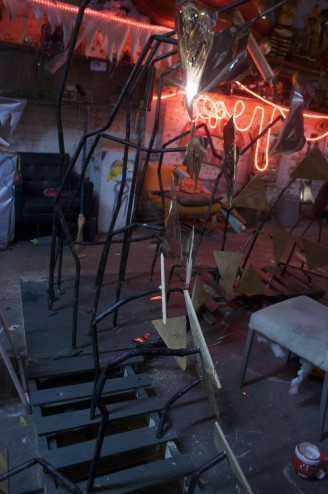
photo by E.A.R.
brooklyn spaces: I read the interview you did with Nonsense NYC some years ago, where you talked about how
for one party you needed sheets, and so you called all these hospitals to see if
they would donate sheets.
Sari: We do have to hustle to get things,
but you can have good adventures that way. That’s the part I like, the moment
when you’re standing in a record store trying to find a square-dance caller or
something else that you never thought you’d be doing.
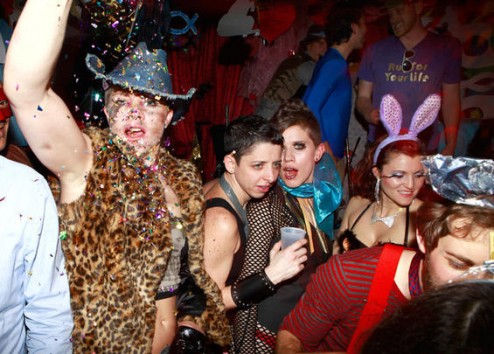
photo from the Village
Voice
brooklyn spaces: What have been some of your
favorite party themes?
Sari: They always surprise you. You never
really know when you pick a theme whether it’s gonna work. One of my favorite
ones was Laundry Day. Who would have known that Laundry Day would turn out to be
such a good theme? There’s a great picture floating around the internet of a
girl playing music in roller curlers in front of the set of the laundry. And
there was one party I really loved like ten years ago called Night of the Living
Toys. That was really beautiful. If you look around the space, you can see
remnants from them all.
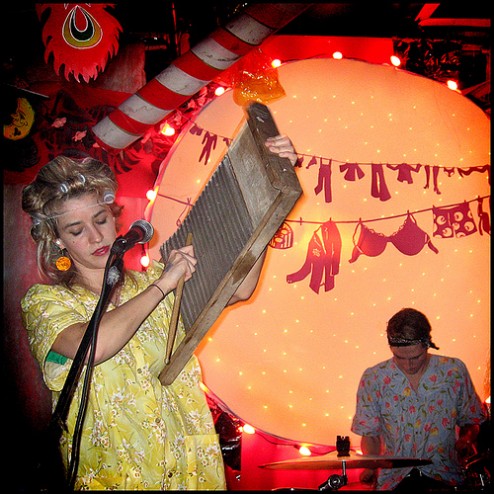
photo from
brokeassstuart.com
brooklyn spaces: How do you find the
artists? Or do they find you?
Sari: Gosh, a lot of them find us. If
they’re supposed to be here, they somehow hear about us, even in Australia or
something. There’s really a lot of good stuff out there, almost endless good
stuff. It’s amazing all the stuff that people know how to do.

photo by E.A.R.
brooklyn spaces: Clearly this is a creative
space for making and appreciating art. But there are people who just see it as a
party house. What do you think about that?
Sari: Well, those people are really
missing the point, because if that’s what we wanted, we would just have a bar.
People who are just looking for a place to drink beer, I encourage them to go to
a bar, there are many. It’s not like we’re against that, but our parties are
meant to be experiential. The whole point is for people to experience art that
they wouldn’t see in the commercial world, or listen to music that they wouldn’t
hear on commercial radio. Not that I mean to disparage beer, and I don’t want to
underestimate the importance of celebration, because that’s really important to
us. We definitely want to encourage more celebration and to help people make
more holidays. People need them! Life is sad sometimes.
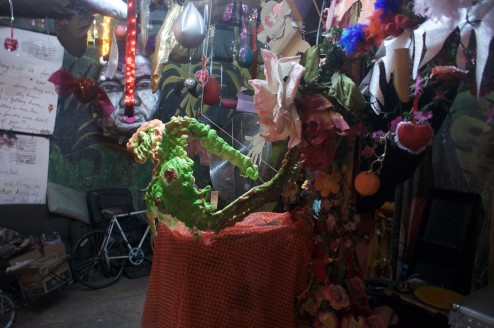
photo by E.A.R.
brooklyn spaces: How do you think being in
Brooklyn has affected Rubulad? Do you feel like what you’re doing and have done
is specific to Brooklyn?
Sari: That’s an interesting question. I’m
a New Yorker and I went to high school in Brooklyn, so I’ve gotten to see
Brooklyn really change. It used to be that everyone in Brooklyn just wanted to
get to the city, and they thought of themselves as bridge-and-tunnel people.
They’d think, if you make it, you go to Manhattan. That’s really changed,
Brooklyn has really become its own city. Manhattan has become a place where the
money lives more than where the people live. Here in Brooklyn there’s more space
for independent stuff to happen, and there’s a lot of help from a great
community. There are so many other spaces, other people who are doing amazing
things. There’s a lot of cross-pollination between different groups, and we work
with many groups who do things that are so different than we do. What
was the last part of that question?

photo by Julia Roberts
brooklyn spaces: Do you feel like what
you’re doing here is specific to Brooklyn?
Sari: Well, for years we thought that we
were the only space like this in the world. We didn’t know that there were other
Rubulads all over America and all over the world. I guess Burning Man was the
first time we were like, “Holy shit, there are so many other people doing
stuff!” The way we do things is specific to where we are, for sure, but we have
connections to so many different kinds of spaces all over the place. I have a
desire to live a life that doesn’t involve a certain kind of people, and I’ve
been able to achieve that. I’m happy to never have to go to Midtown to work and
live that sort of life. In New York that’s pretty hard to achieve, since it’s so
expensive to live here. But there’s something about the grit of the struggle in
Brooklyn that gives people a little added bite and energy. There’s so much going
on right now, it’s a really good time around here, in Bushwick, Bed-Stuy. There
are so many groups around that are really amazing, like the Groove Hoopers, or
the Chicken Hut people. They’re like gutter-punk bike-jousters, and they throw a
heck of a party. And we love Secret Project Robot. There’s so much going on
in Brooklyn that we’re really excited about.

brooklyn spaces: Do you have any advice for
creative people who are trying to figure out how to be involved in something
like Rubulad?
Sari: There was a boy in here who once
said in an interview, “Do art, be art, live art,” and that made me so happy. I
want to encourage people to not be shy, to just make stuff and share it, because
that’s what it’s for. I hope more people will make more spaces and do more weird
theaters and galleries. If you decide to create your own thing and make it
happen the way you want to, other people will enjoy it and join in.
***
Like this? Read about other underground performance & party spaces: 12-turn-13, Monster
Island, Flux
Factory, Gemini
& Scorpio loft, The
Lab (Electric Warehouse), Red Lotus
Room, Big Sky
Works, Newsonic, Gowanus
Ballroom
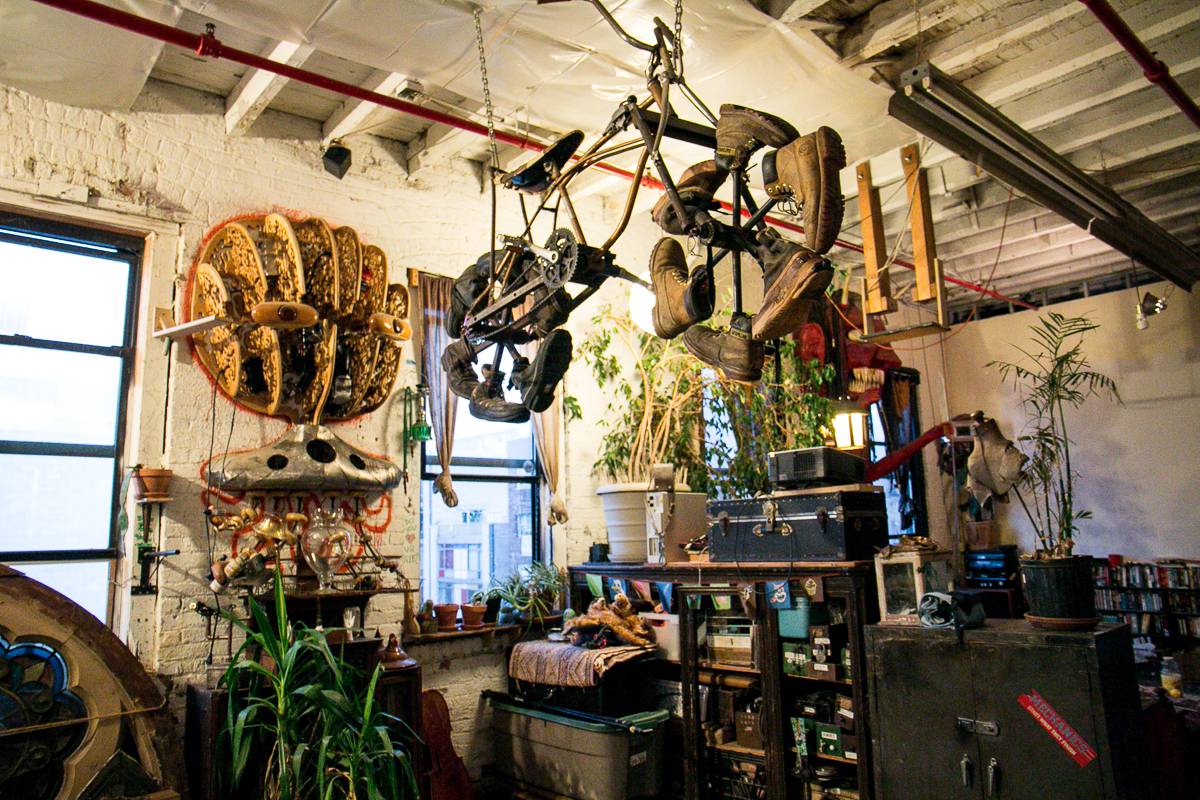
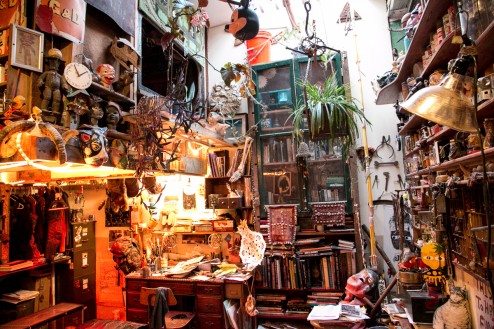
![Chicken Hut founder Greg H. at Bike Kill 2014 [pic by Alix Piorun]](https://www.brooklyn-spaces.com/wp-content/uploads/2015/05/Screen-Shot-2015-05-18-at-7.02.53-PM-494x328.png)
